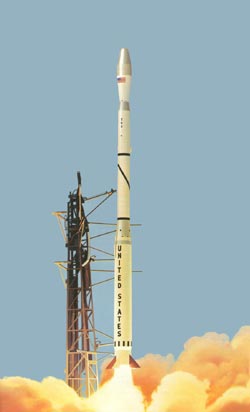|
Scout Launch History
 The Scout Launch Vehicle performed three types of missions – probe, reentry, and orbital. In a probe mission the vehicle was launched upward, and when gravity overcame its launch energy it would fall back to earth. In a reentry mission the vehicle was pointed back into the atmosphere after it reached its peak altitude, and then the last stage rocket was fired so that the payload reentered the atmosphere at a high velocity. In an orbital mission the Scout vehicle delivered the payload into Earth orbit. Probe, reentry, and orbital launches were made at the Wallops Island site in Virginia. Vandenberg AFB in California was used for launching polar orbital missions, and the San Marco site in Africa was used for placing payloads in a near-equatorial orbit. Spacecraft launched by Scout performed a variety of tasks. They measured characteristics of the space environment; they provided navigation aids; they tested materials under reentry conditions; one measured the effect of zero gravity on the inner ear (of a frog); another confirmed an aspect of Einstein’s relativity theory. An astronomy satellite launched by Scout was the first instrument to detect a black hole. In his book Frozen Star, astronomer George Greenstein wrote of this satellite: “……this one satellite came close to transforming astronomy……Rarely in the history of science has a single instrument made such a contribution to a field.” No doubt each spacecraft launched by Scout could be the subject of a fascinating book, but here we will only list each Scout launch and the type of experiment it carried. The Scout Launch Vehicle performed three types of missions – probe, reentry, and orbital. In a probe mission the vehicle was launched upward, and when gravity overcame its launch energy it would fall back to earth. In a reentry mission the vehicle was pointed back into the atmosphere after it reached its peak altitude, and then the last stage rocket was fired so that the payload reentered the atmosphere at a high velocity. In an orbital mission the Scout vehicle delivered the payload into Earth orbit. Probe, reentry, and orbital launches were made at the Wallops Island site in Virginia. Vandenberg AFB in California was used for launching polar orbital missions, and the San Marco site in Africa was used for placing payloads in a near-equatorial orbit. Spacecraft launched by Scout performed a variety of tasks. They measured characteristics of the space environment; they provided navigation aids; they tested materials under reentry conditions; one measured the effect of zero gravity on the inner ear (of a frog); another confirmed an aspect of Einstein’s relativity theory. An astronomy satellite launched by Scout was the first instrument to detect a black hole. In his book Frozen Star, astronomer George Greenstein wrote of this satellite: “……this one satellite came close to transforming astronomy……Rarely in the history of science has a single instrument made such a contribution to a field.” No doubt each spacecraft launched by Scout could be the subject of a fascinating book, but here we will only list each Scout launch and the type of experiment it carried.
SCOUT LAUNCH VEHICLE DESCRIPTION
Motors and Structure
Flight Control
Sequencing the Flight Events
Stage Separation
Destruct System and Radar Beacon Command Destruct
Electrical Power
Launch History
Launch List
|